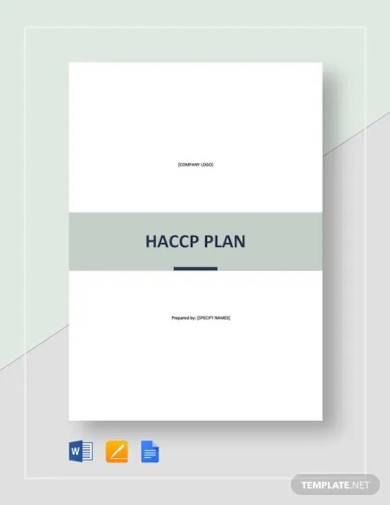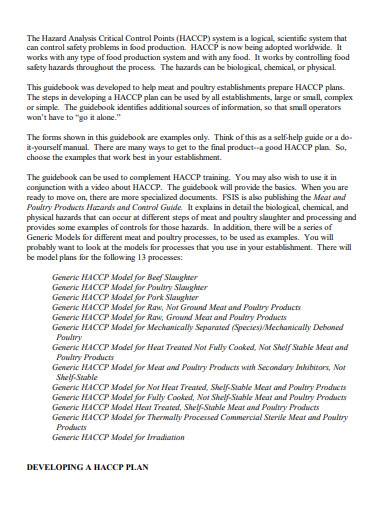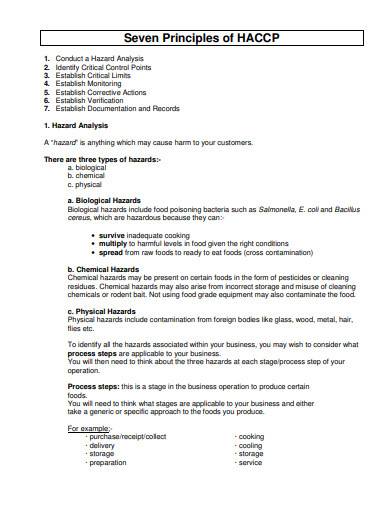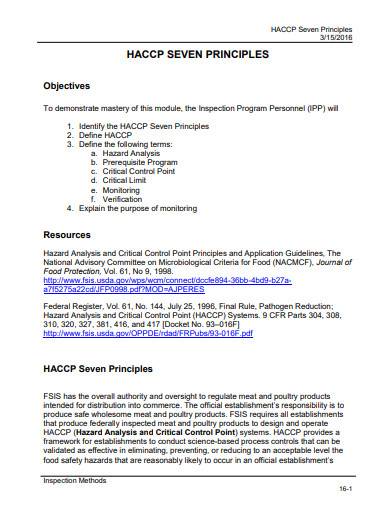Are you an owner of a food company or manufacturing facility? Your business should implement the HACCP system as it is a very significant part of your company quality assurance program. It is the essential foundation of your company’s product safety system and suits the umbrella quality assurance program. But in order to execute this system, you need to acquire knowledge and understanding of the system, commitment, planning, and resources. So, we provide in this article some relevant steps that can assist you in this matter. Plus, we have some templates that you can download freely.
FREE 4+ HACCP Principles & Plans Samples
1. HACCP Plan Template

2. Guidebook For Preparation of HACCP Plan
3. Seven Principles of HACCP
4. HACCP Seven Principles Template
5. Sample HACCP Plan Template
What is HACCP?
The book “HACCP: A Toolkit for Implementation” explains that Hazard Analysis and Critical Control Point (HACCP) is a systematic method to determine, evaluate, and monitor food safety hazards. The concept of this system can be applied to new or current products and processes, and throughout the food chain from primary production to consumption.
How to Create HACCP Principles & Plans
Similar in structure and design to project plans commonly used in various companies, implementing HACCP principles along with a project plan requires a list of steps augmented with resources and provisions created through research and testing for development of technical procedures, critical control points, and other critical limits.
Running a successful business can be possible when you have a plan so that you are aware about the things you need to work on. In this section, we suggest that you follow the steps below:
1. Create HACCP policy and objectives
Do you need to minimize the number of customer complaints by 20% in the previous year? Do you want to complete food safety induction training for new employees before the start of job? Consider your goals and objectives that your food business establishes in producing and providing safe and proper food to your customers.
You should develop SMART (Specific, Measurable, Achievable, Realistic, and Timely) objectives by using your business data while aiming to improve some areas of your business, associate actual targets to your objectives, etc.
2. Appoint the core HACCP team coordinator and form the team
According to the book “HACCP: Principles and Applications,” you must designate a person responsible for the implementation of HACCP plan, as well as members of the HACCP team for the food facility and target product. A HACCP team coordinator should have strong communication skills and one who is able to relate with all levels of staff and build trust.
While the team should include multidisciplinary members who are familiar with all aspects of the production process, and specialists in particular areas like microbiology or engineering.
3. Specify the product with your HACCP team and construct flow diagram
List the target food products, identify each product, list raw materials and ingredients. You need to describe the process by constructing a flow diagram. Create individual flow diagrams for each product that document and type of critical control points (CCP) for specific hazards.
4. Conduct a hazard analysis
Analyze the likely hazards that could occur in a manufacturing process. Record the hazard analysis and risk categories connected with the target products, their ingredients, and for the hazards in the whole product food chain. Document descriptions of each CCP such as the type of hazard, procedures or processes to control the hazard, etc.
5. Identify critical control points
Write the monitoring procedures for the CCP and critical limits, monitoring frequency, and names of the persons who are responsible for specific monitoring activities. Include deviation procedures for each CCP that determine action to be initiated if monitoring specifies that a CCP is out of control.
FAQ
Based on an article, the 7 principles of HACCP are hazard analysis, CCP identification, setting up critical limits, monitoring procedures, corrective actions, verification procedures, and record-keeping and documentation.What are the 7 principles of HACCP?
According to North Dakota State University, a food safety plan for all other food processing businesses at 21 U.S.C. 350g is required by the Food Safety Modernization Act 2010 (FDA).Who needs a HACCP plan?
The most important part of HACCP is that it is a preventive system of monitoring food safety hazards. Prevention of hazards cannot be fulfilled by end product inspection. Controlling the production process with HACCP provides the best way. The integral roles and responsibilities under HACCP are formation of an HACCP team, description of the food and its intended use, classification of the consumers of the food, development and verification of a process flow diagram, conduction of a hazard analysis, identification of critical control points and execution of HACCP principles and plan.What is the most important part of a HACCP implementation?
What are the roles and responsibilities under HACCP?
Therefore, a proper application of HACCP system in your food business is very important to control any area or point in the food system that could contribute to a hazardous event such as the possible occurrence of contaminants, pathogenic microorganisms, physical objects, chemicals, raw materials, a process, and many more. Creating a systematic HACCP plan is beneficial in improving the safety and good quality of your food products. To start, download our plan template in this article now!
Related Posts
Diet Plan
FREE 10+ Marketing Implementation Plan Samples [ Digital, Social Media, Strategy ]
FREE 10+ Teacher Training Plan Samples in MS Word | Google Docs | Apple Pages | PDF
FREE 16+ Construction Phase Plan Samples in PDF | MS Word
FREE 9+ Sample Advertising Plan Templates in PDF | MS Word
FREE 10+ HR Consulting Business Plan Samples in MS Word | Google Docs | Pages | PDF
FREE 10+ Media Strategy Plan Samples in PDF | MS Word | Apple Pages | Google Docs
FREE 5+ Digital Marketing Strategy Plan Samples in MS Word | Google Docs | Apple Pages | PDF
FREE 10+ Investigation Plan Samples in PDF | DOC
FREE 11+ Data Management Plan Samples in PDF | DOC
9+ Cost Management Plan Samples in PDF | DOC
FREE 8+ Debt Management Plan Samples in PDF | DOC
FREE 10+ Sales Management Plan Samples in PDF | MS Word | Apple Pages | Google Docs
FREE 4+ 30-60-90-Day Marketing Plan Samples in MS Word | Google Docs | Apple Pages | PDF
FREE 10+ Higher Education Lesson Plan Samples in MS Word | Pages | Google Docs | PDF




